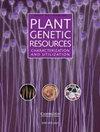Horseradish (Armoracia rusticana G. Gaertn., B. Mey. & Scherb.) cultivated in Trentino-Alto Adige (northern Italy) characterized by biometric traits and glucosinolate content
IF 0.7
4区 生物学
Q3 PLANT SCIENCES
Plant Genetic Resources: Characterization and Utilization
Pub Date : 2023-05-08
DOI:10.1017/s1479262123000254
引用次数: 0
Abstract
Horseradish is a crop grown for its edible underground parts. The development of new cultivars is hindered by the species' predominant vegetative reproduction, making it essential to evaluate locally cultivated accessions to identify new types suitable for cultivation. To this end, 11 horseradish accessions from family vegetable gardens in Trentino-Alto Adige, Italy were examined using 26 qualitative and six quantitative morphological descriptors and characterized by the five major glucosinolates (GSLs) present in the rhizome compared to a reference cultivar. A wide range of variability was observed for the considered qualitative morphological traits. The rhizome's top and basal diameters were 9.9 and 6.2 cm, respectively, with an average fresh weight of 521 g. Total GSL content ranged between 79.5 and 133.5 μmol/g dry weight (DW), with sinigrin (SIN) being the primary component at an average content of 110.0 μmol/g DW. Differences among the investigated accessions were noted for quantitative traits describing their productive features and for GSL content. A positive correlation was discovered between the biometric traits of the plant's underground parts and the SIN and total GSL content, suggesting a link between the quality and yield of the edible product. According to the multivariate analysis, accessions were grouped into three main clusters: the largest of the reference cultivar and the majority of accessions with similar productive and qualitative traits; another featuring two with good qualitative and productive characteristics. The investigated accessions proved to be a valuable germplasm source for cultivating the species.辣根(Armoracia rusticana G. Gaertn.)b:好的。& Scherb.)种植在Trentino-Alto Adige(意大利北部),以生物特征和硫代葡萄糖苷含量为特征
辣根是一种因其地下部分可食用而种植的作物。新品种的发展受到植物营养繁殖优势的阻碍,因此必须对本地栽培的材料进行评估,以确定适合栽培的新品种。为此,对来自意大利Trentino-Alto Adige家庭菜园的11份辣根进行了26个定性和6个定量形态学描述,并与参考品种进行了比较,确定了根状茎中存在的5种主要硫代葡萄糖苷(GSLs)。广泛的变异性被观察到考虑的定性形态性状。根茎顶端直径9.9 cm,基部直径6.2 cm,平均鲜重521 g。GSL总含量在79.5 ~ 133.5 μmol/g干重(DW)之间,以紫红素(SIN)为主要成分,平均含量为110.0 μmol/g DW。所调查的材料在描述其生产特征的数量性状和GSL含量方面存在差异。植物地下部分的生物特征特征与SIN和总GSL含量呈正相关,表明食用产品的质量和产量之间存在联系。通过多变量分析,将材料分为3个主要聚类:最大的参考品种和大多数具有相似生产性状和质量性状的材料;二是具有良好的质量和生产特点。所调查的材料是一种有价值的种质资源。
本文章由计算机程序翻译,如有差异,请以英文原文为准。
求助全文
约1分钟内获得全文
求助全文
来源期刊

Plant Genetic Resources: Characterization and Utilization
Agricultural and Biological Sciences-Agronomy and Crop Science
CiteScore
2.80
自引率
0.00%
发文量
29
审稿时长
>12 weeks
期刊介绍:
Plant Genetic Resources is an international journal which provides a forum for describing the application of novel genomic technologies, as well as their integration with established techniques, towards the understanding of the genetic variation captured in both in situ and ex situ collections of crop and non-crop plants; and for the airing of wider issues relevant to plant germplasm conservation and utilisation. We particularly welcome multi-disciplinary approaches that incorporate both a technical and a socio-economic focus. Technical aspects can cover developments in technologies of potential or demonstrated relevance to the analysis of variation and diversity at the phenotypic and genotypic levels.
 求助内容:
求助内容: 应助结果提醒方式:
应助结果提醒方式:


